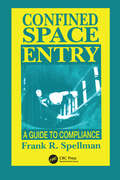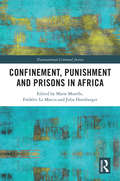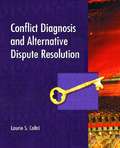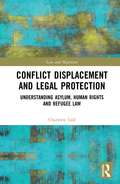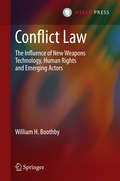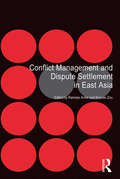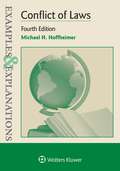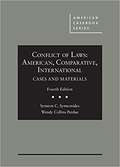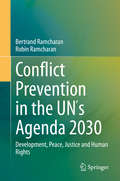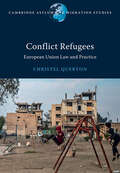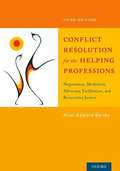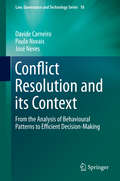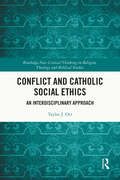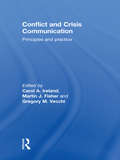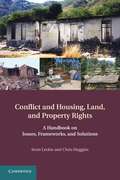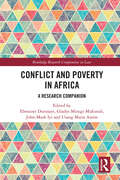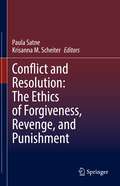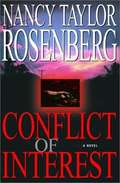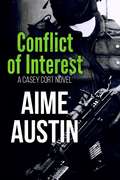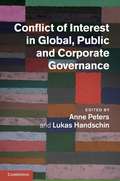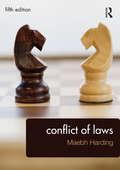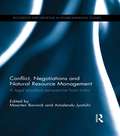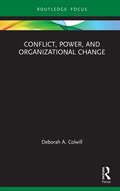- Table View
- List View
Confined Space Entry: Guide to Compliance
by Frank R. SpellmanFROM THE PREFACEThis book brings together (in one text) all of the Occupational Safety and Health Administration's regulatory requirements for making safe and proper confined space entries. Because confined space entry is a complicated procedure-and a process that contains inherent risks-those concerned with safety in the work place are constan
Confinement, Punishment and Prisons in Africa (Transnational Criminal Justice)
by Marie Morelle, Frédéric Le Marcis and Julia HornbergerThis interdisciplinary volume presents a nuanced critique of the prison experience in diverse detention facilities across Africa. The book stresses the contingent, porous nature of African prisons, across both time and space. It draws on original long-term ethnographic research undertaken in both Francophone and Anglophone settings, which are grouped in four parts. The first part examines how the prison has imprinted itself on wider political and social imaginaries and, in turn, how structures of imprisonment carry the imprint of political action of various times. The second part stresses how particular forms of ordering emerge in African prisons. It is held that while these often involve coercion and neglect, they are better understood as the product of on-going negotiations and the search for meaning and value on the part of a multitude of actors. The third part is concerned with how prison life percolates beyond its physical perimeters into its urban and rural surroundings, and vice versa. It deals with the popular and contested nature of what prisons are about and what they do, especially in regard to bringing about moral subjects. The fourth and final part of the book examines how efforts of reforming and resisting the prison take shape at the intersection of globally circulating models of good governance and levels of self-organisation by prisoners. The book will be an essential reference for students, academics and policy-makers in Law, Criminology, Sociology and Politics.
Confirming Justice—Or Injustice?: A Guide to Judging RBG's Successor
by Alan DershowitzIn Confirming Justice—Or Injustice?, Alan Dershowitz—New York Times bestselling author and one of America&’s most respected legal scholars—contemplates the past, present, and future of the Supreme Court, from the death of Ruth Bader Ginsburg to the confirmation battle looming over President Trump&’s nomination of Judge Amy Coney Barrett. Alan Dershowitz has been called &“one of the most prominent and consistent defenders of civil liberties in America&” by Politico and &“the nation&’s most peripatetic civil liberties lawyer and one of its most distinguished defenders of individual rights&” by Newsweek. He is also a fair-minded and even-handed expert on the Constitution and American government, and in this book offers his knowledge and insight to help readers understand the current circumstances surrounding the Supreme Court and the looming partisan battle for its future. Confirming Justice—Or Injustice? is an analysis of every aspect of the possible confirmation of Judge Amy Coney Barrett to fill the vacant seat left by the death of Ruth Bader Ginsburg. It includes timely commentary on the history and process of confirming justices to the Supreme Court, notes about what might happen if the process is changed—such as by court packing or instituting age or term limits for justices—and discussion of the roles of the various people and groups who might have input on the confirmation, from the president to the senate to the judiciary committee to the Constitution itself. In the end, Confirming Justice—Or Injustice? represents an icon in American law and politics reckoning with an increasingly politicized and polarized nomination-and-confirmation process for judges and what those shifts might mean for the country, both now and in days to come. It is essential reading for anyone interested in or concerned about Trump's nomination of Amy Coney Barrett and the process of her possible confirmation, the legacy of Ruth Bader Ginsburg, and the future and fate of the Supreme Court—and American democracy itself.
Conflict Diagnosis And Alternative Dispute Resolution
by Laurie ColtriFilling a void in the market,Conflict Diagnosis, Brief Editionuses the innovation of the Conflict Diagnosis concept to provide an in-depth appreciation of ADR processes. The survey takes both a true sociological perspective on the interdisciplinary topic of alternative disputes and prefaces these descriptions with an in-depth exploration of the theoretical and empirical basis for understanding their uses, misuses, indications and counterindications to provide readers with a thorough and complete approach to understanding, evaluating and developing strategies and tactics to address interpersonal conflict.The survey addresses basic definitions, dispute resolution processes, preconceptions about conflict and how they short change us, conflict diagnosis, the nine steps of conflict diagnosis, alternative dispute resolution processes, using conflict diagnosis to manage legal disputes and select ADR processes.For human resources personnel, dispute resolution system designers, trainers and ombuds, as well as ADR neutrals and neutrals-in-training.
Conflict Displacement and Legal Protection: Understanding Asylum, Human Rights and Refugee Law (Law and Migration)
by Charlotte LülfWhile the 21st century bears witness to several conflicts leading to mass displacement, the conflict in Syria has crystallised the need for a solid legal framework and legal certainty. This book analyses the relevant legal instruments for the provision of a protection status for persons fleeing to Europe from conflict and violence. It focuses on the conceptualisation of conflict and violence in the countries of origin and the different approaches taken in the interpretation of them in the 1951 Refugee Convention, the Recast Qualification Directive of the European Union and the European Convention on Human Rights. It traces the hierarchical order of protection granted, starting with refugee protection status, to subsidiary protection status and finally with the negative protection from non-refoulement. Recent case law and asylum status determination practices of European countries illustrate the obstacles in the interpretation as well as the divergence in the application of the legal instruments. The book fills an important gap in examining the current practices of key actors, including the United Nations High Commissioner for Refugees and European states, tracing changes in national and international policies and revealing discrepancies towards contemporary approaches to conflicts. It refines the interaction and cross-fertilisation of the different relevant fields of European asylum law, human rights law and the laws of armed conflict in order to further the development of a harmonised protection regime for conflict-induced displacement.
Conflict Law: The Influence of New Weapons Technology, Human Rights and Emerging Actors
by William H. BoothbyTopics as diverse as the evolving spectrum of conflict, innovations in weaponry, automated and autonomous attack, the depersonalisation of warfare, detention operations, the influence of modern media and the application of human rights law to the conduct of hostilities are examined in this book to see to what extent existing legal norms are challenged. The book takes each topic in turn, explains relevant provisions of contemporary law and analyses exactly where the legal problem lies. The analysis then develops the theme, examining for example the implications of current rules as to deception operations for certain applications of cyber warfare. The text is written in an accessible style, and demonstrates the continuing relevance of established rules and the importance of compliance with them. Useful for academics, military, governments, ministries of defence, ministries of foreign affairs, libraries, diplomats, think tanks, policy units, NGOs, and all others with an interest in law of armed conflict issues such as journalists and students.
Conflict Management and Dispute Settlement in East Asia
by Ramses AmerThrough a multi-disciplinary approach, this volume studies the management and settlement of conflict and disputes in East Asia. Conflict and disputes exist everywhere in human society. The management and settlement of them has become an imperative. This volume is a significant contribution to a broader understanding of the complexities involved in managing and settling disputes and conflicts at regional, inter-state and intra-state levels in the East Asian region. Drawing on expertise in Peace and Conflict, International Relations, and International Law the volume presents to the reader a general picture of how conflict can be managed at the international and regional levels through various mechanisms, in particular, through prominent regional organizations such as ASEAN. It then moves on to case studies at the regional level including inter-state and intra-state conflicts and disputes. The last part of the volume highlights how states resolve their maritime disputes. This has drawn much attention from the international community due to various factors such as the increasing demand for natural resources from the oceans. These disputes disrupt the smooth development of international relations as well as trigger tensions and confrontation between states.
Conflict Of Laws (Examples And Explanations)
by Michael H. HoffheimerA favorite among successful students, and often recommended by professors, the unique Examples & Explanations series gives you extremely clear introductions to concepts followed by realistic examples that mirror those presented in the classroom throughout the semester. Use at the beginning and midway through the semester to deepen your understanding through clear explanations, corresponding hypothetical fact patterns, and analysis. Then use to study for finals by reviewing the hypotheticals as well as the structure and reasoning behind the accompanying analysis. Designed to complement your casebook, the trusted Examples & Explanations titles get right to the point in a conversational, often humorous style that helps you learn the material each step of the way and prepare for the exam at the end of the course. Clear, informal, and even humorous, Examples & Explanations: Conflicts of Law, 3E, explores all of the topics covered in Conflicts courses, including personal jurisdiction and the Erie doctrine. It provides full treatment of traditional and modern approaches to choice of law and proof of law, with up-to-date coverage of constitutional limits. Big-picture overviews and accurate statement rules are reinforced with concrete examples and test-taking tips. The powerful Examples & Explanations pedagogy works especially well for Conflict of Laws where students gain understanding of rules and policies by applying them to new fact patterns. Summaries of leading cases found in most casebooks and a modular organization allows easy adaptation to any course. The Third Edition adds new Supreme Court decisions, provides a new chapter on transfers and forum non conveniens, and adds coverage of the new European Union rules on inheritance and wills.
Conflict Of Laws: American, Comparative, International Cases And Materials (American Casebook)
by Symeon C. SymeonidesThis versatile and pedagogically effective book brings together in a coordinated way the rich and diverse perspectives and 80 years combined teaching experience of two highly respected conflicts scholars: the author of 30 annual surveys of choice-of-law cases and drafter of three conflicts codifications, and the author of a path-breaking, established casebook on civil procedure. The book presents the real world of conflict law, behind the leading cases and beyond America's borders, through distilled documentation of what courts actually do and strategically placed extensive information about international practice and the law of other countries.
Conflict Prevention in the UN´s Agenda 2030: Development, Peace, Justice and Human Rights
by Robin Ramcharan Bertrand RamcharanThis book analyses the UN’s Agenda 2030 and reveals that progress is lagging on all five interlocking and interdependent themes that are discussed: conflict prevention, development, peace, justice and human rights. Many voices have already been raised, including that of the UN Secretary-General that the Sustainable Development Goals will not be met by 2030 unless there is a re-doubling of efforts. Still, on development as such, there is much striving. The book puts the concept of preventive diplomacy into all of the issues of modern international relations, from the US/China confrontation to the various conflicts bedeviling Africa. It bridges the two worlds of the international relations specialist on the one hand and that of the academic interested in UN affairs on the other hand. There is normally little contact between those two specializations. The authors have taken several current issues to show how the millennium debates and the SDG targets are relevant to "realist school" conflicts, and that there is work under way to operationalize ideas and theories in this respect. This is the first ever discussion of the conflict prevention dimension in the UN’s Agenda 2030 which seeks to advance sustainable development with a view to reinforcing peace and justice on the foundations of respect for universal human rights.
Conflict Refugees: European Union Law and Practice (Cambridge Asylum and Migration Studies)
by Christel QuertonBased on a systematic and empirical comparative study of six European Union countries, Christel Querton explores judicial decision-making in the context of persons fleeing armed conflicts in the EU. Addressing and redressing misconceptions about the relevance of the Refugee Convention, this book demonstrates how appellate authorities across the EU approach situations of armed conflict predominantly through outdated understandings of warfare and territoriality. Thus, they apply a higher standard of proof than is warranted by international refugee law. Adopting a gender perspective, Querton also shows how appellate authorities fail to acknowledge the gender-differentiated impact of armed conflicts. Drawing from gender and security studies, this book proposes an original conceptual framework which, supported by existing international legal standards, reframes the definition of 'refugee' and better reflects the reality of violence in modern-day conflicts. In doing so, it re-asserts the Refugee Convention as the cornerstone of international protection.
Conflict Resolution For The Helping Professions: Negotiation, Mediation, Advocacy, Facilitation, and Restorative Justice
by Allan Edward BarskyWhen people think of conflict, they often think of fights, wars, arguments, hot tempers, and hurtful consequences. This book provides helping professionals with the theory, strategies, and skills they need to deal with conflict in a manner that is respectful, collaborative, and constructive. This text illustrates how helping professionals can incorporate evidence-based models of conflict resolution to work more effectively and enjoyably with clients, coworkers, supervisors, and others. Practitioners will learn how to respond effectively when others use power, positions, and competition. Whereas many conflict resolution texts focus on one method or approach to practice, this textbook provides practitioners with various models that they can incorporate in their roles as negotiators, counselors, mediators, facilitators, advocates, and peacebuilders.
Conflict Resolution and its Context: From the Analysis of Behavioural Patterns to Efficient Decision-Making (Law, Governance and Technology Series #18)
by Davide Carneiro Paulo Novais José NevesThis book studies how technological solutions can be used to alleviate the current state of legal systems, with their clogged up courtrooms and inefficient conflict resolution methods. It reviews the shortcomings and disadvantages of traditional and alternative conflict resolution methods and turns to Artificial Intelligence for problem-solving techniques and solutions. The book is divided into four parts. The first part presents a general and systematic analysis of the current state of the legal systems, identifying the main problems and their causes It then moves on to present UM Court: a framework for testing and prototyping conflict resolution services. This framework was developed with the objective of using Artificial Intelligence techniques to build a service environment for conflict resolution. The third part of the book takes a step into the future by analyzing the use of Intelligent Environments in the support of conflict management and resolution. It describes the approach taken and the experiments performed in the Intelligent Systems Lab of the University of Minho. The final part of the book contains the conclusions and shows the potential advantages of the use of Intelligent Environments as a way to implement better conflict resolution procedures (virtual or real), in which all the participants have access to more and better information and are able to take better informed decisions.
Conflict Resolution in the Twenty-first Century: Principles, Methods, and Approaches
by Jacob Bercovitch Richard Jackson"An outstanding overview and assessment of contemporary conflict resolution; the authors never avoid the challenging questions, or critical answers. " ---Åshild Kolås, Program Leader, Conflict Resolution and Peacebuilding Program, International Peace Research Institute, Oslo (PRIO) "Conflict Resolution in the Twenty-first Centuryis very readable and crystallizes the breadth of conflict resolution today and the relevance of new approaches for the future. " ---Jeffrey W. Helsing, Deputy Director, Education and Training Center, United States Institute of Peace "This concise and readable volume offers readers an impressive sample of the responses---both traditional and emerging---in the conflict resolution toolbox, crisply outlining how they relate to today's dynamic conflict environment. " ---Chester A. Crocker, James R. Schlesinger Professor of Strategic Studies, Edmund A. Walsh School of Foreign Service, Georgetown University "Authoritative, well written, and astoundingly broad and deep. Must-reading for all students of international and ethnopolitical conflict resolution. " ---Dean G. Pruitt, Distinguished Scholar in Residence, Institute for Conflict Analysis and Resolution, George Mason University "The idea that the nature and methods of conflict resolution ought to change as the kinds of conflict that dominate the world-at-large shift is very appealing. " ---Professor Lawrence Susskind, Director, MIT-Harvard Public Disputes Program "A comprehensive overview, based upon in depth familiarity with the research, scholarship, and practice in the field. " ---Louis Kriesberg, Professor Emeritus of Sociology and Maxwell Professor Emeritus of Social Conflict Studies, Syracuse University In the past, arbitration, direct bargaining, the use of intermediaries, and deference to international institutions were relatively successful tools for managing interstate conflict. In the face of terrorism, intrastate wars, and the multitude of other threats in the post-Cold War era, however, the conflict resolution tool kit must include preventive diplomacy, humanitarian intervention, regional task-sharing, and truth commissions. Here, Jacob Bercovitch and Richard Jackson, two internationally recognized experts, systematically examine each one of these conflict resolution tools and describe how it works and in what conflict situations it is most likely to be effective. Conflict Resolution in the Twenty-first Centuryis not only an essential introduction for students and scholars, it is a must-have guide for the men and women entrusted with creating stability and security in our changing world. Jacob Bercovitch is Professor of International Relations at the University of Canterbury, New Zealand. Richard Jackson is Reader in International Politics at Aberystwyth University, United Kingdom. Cover illustration © iStockphoto. com
Conflict and Catholic Social Ethics: An Interdisciplinary Approach (Routledge New Critical Thinking in Religion, Theology and Biblical Studies)
by Taylor J. OttThis book focuses on the question of how to understand conflict and its place in Catholic and Christian social ethics. The author examines Catholic social teaching (CST) for its explicit mentions of conflict or contention and analyzes the way that CST addresses the subjects of peace, labor, and environment. While CST offers precedent to think about conflict within the frame of Catholic ethics, its lack of explicit engagement remains a major obstacle to a full, rich, and concrete understanding of the fabric of society and the work of social justice. Any social ethic that is not informed by the presence of conflict misses a major dynamic in society, and therefore leads to ethical judgements that are at best inadequate, and at worst, actively harmful. Building upon the insight of respected thinkers within Catholic social thought, this study is based on an interdisciplinary method that engages sociology, political theory, postcolonial theory, and intersectional feminist ethics. The book will be of particular interest to theological ethicists and those who work with modern CST.
Conflict and Crisis Communication: Principles and Practice
by Carol A. Ireland Martin J. Fisher Gregory M. VecchiConflict and crisis communication is the management of a critical incident which has the potential for resolution through successful negotiations. This can include negotiating with individuals in crisis, such as those threatening self-harm or taking individuals hostage as part of emotional expression, and also critical incidents such as kidnapping and terrorist activities. By focusing on the empirical and strong theoretical underpinnings of critical incident management, and including clear demonstrations of the practical application of conflict and crisis communication by experts in the field, this book proves to be a practical, comprehensive and up-to-date resource. Discussion of relevant past incidents – such as the 1993 WACO siege in the United States – is used to enhance learning, whilst an examination of the application of critical incident management to individuals with mental disorder offers groundbreaking insight from clinicians working in this area. Conflict and Crisis Communication is an excellent source of reference for national and international law enforcement agencies, professionals working in forensic settings, and also postgraduate students with an interest in forensic psychology and forensic mental health.
Conflict and Housing, Land and Property Rights
by Scott Leckie Chris HugginsHousing, land and property (HLP) rights, as rights, are widely recognized throughout international human rights and humanitarian law and provide a clear and consistent legal normative framework for developing better approaches to the HLP challenges faced by the UN and others seeking to build long-term peace. This book analyses the ubiquitous HLP challenges present in all conflict and post-conflict settings. It will bridge the worlds of the practitioner and the theorist by combining an overview of the international legal and policy frameworks on HLP rights with dozens of detailed case studies demonstrating country experiences from around the world. The book will be of particular interest to professors and students of international relations, law, human rights, and peace and conflict studies but will have a wider readership among practitioners working for international institutions such as the United Nations and the World Bank, non-governmental organizations, and national agencies in the developing world.
Conflict and Poverty in Africa: A Research Companion (Routledge Research Companions in Law)
by John-Mark Iyi Ebenezer Durojaye Gladys Mirugi-Mukundi Usang Maria AssimThe contributors to this book examine the conceptual issues relating to the link between conflict and poverty as well as presenting case studies of countries often regarded as ‘hot spots’ for conflict in Africa. They also explore the roles of regional and sub-regional bodies and institutions in addressing the causes of poverty and mitigating the impacts of conflict on vulnerable and marginalized groups.Africa is often regarded as the epicentre of conflicts worldwide. Virtually every part of the continent is currently engulfed in one form of conflict or another. Beyond the loss of life, conflicts have brought untold hardship to millions and have derailed social and economic development on the continent. Written by African academics, this book is divided into three sections, the first of which discusses the factors that fuel conflicts and the nature and impacts of conflicts on vulnerable groups. The second section comprises case studies of South Sudan, Central African Republic, Nigeria, Ethiopia, South Africa, Uganda, and Cameroon. These countries are representative of the sub-regional dynamics of Africa – west, east, central, and south – reflecting the diversity of the continent. The final section examines the role of key institutions and bodies in Africa in mitigating the impact of conflict on the socioeconomic lives of the people in the region. Bodies discussed include the African Union, Economic Community of West African States, Southern African Development Community, and the East African Community.The book will be an invaluable resource for researchers, academics and policymakers working in the areas of law, political science, human rights, peace studies, development studies, and African studies.
Conflict and Resolution: The Ethics of Forgiveness, Revenge, and Punishment
by Paula Satne Krisanna M. ScheiterGiven the current climate of political division and global conflict it is not surprising that there has been an increasing interest in how we ought to respond to perceived wrongdoing, both personal and political. In this volume, top scholars from around the world contribute all new original essays on the ethics of forgiveness, revenge, and punishment. This book draws on both historical and contemporary debates in order to answer important questions about the nature of forgiveness, the power of apology, the relationship between punishment and revenge, the path to reconciliation, the morality of blame, and the role of forgiveness in political conflict.Chapter 16 is available open access under a Creative Commons Attribution 4.0 International License via link.springer.com.
Conflict of Interest
by Nancy Taylor RosenbergThis is a story where a number of people, including a LD man, get twisted in a complex plot of crime and violence.
Conflict of Interest (A Casey Cort Novel #5)
by Aime AustinSylvie Fox writing as Aime Austin presents this Casey Cort legal thriller. Troy Duncan has just two worries on his mind: how he is going to give his two young children and fiancé a Christmas they deserve and whether his job at a struggling restaurant will last through the winter. As he leaves work early on another slow night, he runs into something that changes his life forever. Cleveland Police Officer Marc Baldwin has been on the job for more than two decades, risking his life every day to keep the city streets safe for others. One cold night in December, he gets a routine call to break up drug activity in the newly popular Flats district, but what happens there is anything but routine, as circumstances prompt Marc to draw—and use—his service weapon. Attorney Casey Cort is finally changing her life for the better. After an uplifting year of pro bono adoption work under her belt, she is hoping to start a practice free of the emotional turmoil and problems of criminal defense and divorce. Easier said than done, particularly when a new, high-profile referral comes from a most unlikely source. Once again, Casey finds herself in the middle of a major controversy—and a city on the verge of riot. In this fourth installment of the Casey Cort series, Aime Austin—a former trial lawyer in Cleveland—weaves another tale that blends the best of today’s top legal thrillers with the heart and soul of women’s fiction, in a story ripped from real-world headlines.
Conflict of Interest in Global, Public and Corporate Governance
by Anne Peters Lukas HandschinConflict of interest occurs at all levels of governance, ranging from local to global, both in the public and the corporate and financial spheres. There is increasing awareness that conflicts of interest may distort decision-making processes and generate inappropriate outcomes, thereby undermining the functioning of public institutions and markets. However, the current worldwide trend towards regulation, which seeks to forestall, prevent and manage conflicts of interest, has its price. Drawbacks may include the stifling of decision-making processes, the loss of expertise among decision-makers and a vicious circle of distrust. This interdisciplinary and international book addresses specific situations of conflict of interest in different spheres of governance, particularly in global, public and corporate governance.
Conflict of Laws
by Maebh HardingConflict of Laws provides a straight-forward and accessible introduction to English private international law. It examines the jurisdiction of English courts (and whether their judgments are enforced and recognized overseas) and the effect of foreign judgments in England. Recent years have seen an increased ‘Europeanization’ of English Law which has transformed the subject and this fifth edition takes into account key recent developments and regulations including proposed changes to Brussels I, Rome II, The Maintenance Regulation, Rome III, the proposed Rome IV and the proposed Succession Regulation. ? Harding provides students with a clear understanding using pedagogic methods such as; Key Issues checklists at the start of every chapter to help track important points for further study Figures are used to aid understanding through visual learning Further Reading is included at the end of every chapter to enourage and support additional study ? Further developments addressed in the fifth edition include:• The use of common law doctrines in EU cases such as West Tankers. • The EU imperative for family relationships to be recognized across the EU in the context of citizen’s rights. • Civil Partnerships and recognition of same sex partnership. • Rome III, Rome IV and the distinction between maintenance and matrimonial property.• Adoption, Parental Responsibility and International Child Abduction • Surrogacy and Assisted Reproduction ? Conflict of Laws is an ideal choice for undergraduate and postgraduate students seeking a comprehensive yet accessible introduction to private international law.
Conflict, Negotiations and Natural Resource Management: A legal pluralism perspective from India (Routledge Explorations in Environmental Studies)
by Maarten Bavinck Amalendu JyotishiConflicts over natural resources abound in India, where much of the population is dependent on these resources for their livelihoods. Issues of governance and management are complicated by the competing claims of parallel legal systems, including state, customary, religious, project and local laws. Whereas much has been written about property rights, this unique collection takes a legal anthropological perspective to explore how the coexistence and interaction between multiple legal orders provide bases for claiming property rights. It examines how hybrid legal institutions have developed over time in India and how these impact on justice in the governance and distribution of natural resources. The book brings together original case studies that offer fresh perspectives on the governance of forests, water, fisheries and agricultural land in a diverse range of social and spatial contexts. This brand new research provides a timely and persuasive overview of the fundamental role of parallel legal systems in shaping how people manage natural resources. It will be of interest to scholars and practitioners of environmental law, property law, environmental politics, anthropology, sociology and geography.
Conflict, Power, and Organizational Change (ISSN)
by Deborah A. ColwillA capacity for learning, adapting, and changing is an important facet of organizational resilience. What is involved in generative organizational change? Is it an event, a process, or constantly ongoing? What makes organizational change "good" for the organization? Who has the power to decide what is "good" for the organization and its members? How is it decided? What if there is strong disagreement or conflict? How is that handled? What is the role of organizational members and leaders in these discussions? As these questions demonstrate, the triad of change, power and conflict are intimately linked. The purpose of this book is to explore the topics of change, power and conflict as they relate to the experiences of everyday organizational life. It will provide readers the opportunity to reflect critically on their own local experience and involvement in organizations and to glean actionable wisdom for meaningful engagement and impactful contributions to their organization(s) in the present and future.Conflict, Power, and Organizational Change will be of interest to students, researchers, academics and professional colleagues interested in the fields of business and organizational studies, especially those wanting to get acquainted with the concepts of change, power and conflict in contemporary organizational settings.
